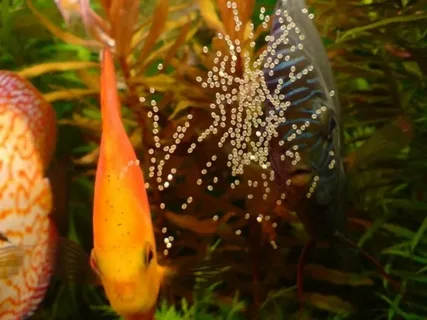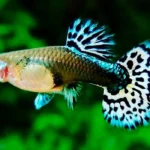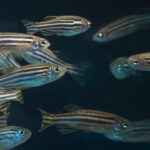Fish reproduction is a fascinating realm beneath the waves—a ballet of instinct, adaptation, and survival. Though human eyes do not always see the complete process, knowing how fish Reproduction reveals a level of aquatic existence that is sophisticated, varied, and sometimes amazing. From the sophisticated courtship rituals to the gentle hatching of miniature fry, the fish reproduction process covers millions of years of evolution.
In this article, we’ll delve into the interesting process of fish reproduction. We’ll examine the varying reproductive methods, describe the processes of mating through hatching, and see how these processes differ between species. If you’re an inquisitive aquarist, a biology buff, or simply someone who’s intrigued about the underwater world, you’re about to get the full picture of how fish transform from eggs into life.

The Basics of Fish Reproduction
Sexual vs Asexual Reproduction
Most fish are sexually reproducing, so they need a male and a female to give birth. Some do it differently, such as the Amazon molly (Poecilia formosa), which reproduces via gynogenesis, a type of asexual reproduction in which the female employs the sperm of a male from a closely related species to stimulate her eggs, though the sperm’s DNA is not utilised.
The majority of fish, however, adopt one of the two principal sexual reproduction strategies:
External fertilisation: Eggs and sperm are released into the water.
Internal fertilisation: Sperm is delivered into the female’s body.
Courtship and Mating Behaviors
Mating Rituals
Even before the eggs are fertilised, most fish practice courtship. These behaviors are meant to:
Ensure species compatibility.
Provide for choosing the healthiest partners.
Coordinate timing for spawning.
Some of them, such as bettas, show bright colors and do dances or fin flares in order to get a mate. Others, such as the cichlids, construct nests or clean up surfaces to demonstrate readiness for parenthood.
Male Competition and Female Choice
In other species, males will fight for access to females by displaying strength, bright colourations, or territorial dominance. Females tend to choose mates based on size, strength, or colouration—all signs of good genes for their future fry.
External Fertilisation – A Numbers Game
Broadcast Spawning
In broadcast spawning, both males and females discharge their gametes (eggs and sperm) into the open water. External fertilization takes place. This technique is usually found in marine species such as
Tuna
Groupers
Coral reef fish
Because this technique is vulnerable to heavy predation and environmental hazards, fish make up for it by producing thousands, and sometimes millions, of eggs.
Nest Spawning
Certain freshwater fish, such as bluegills or sticklebacks, construct nests where the female deposits eggs and the male fertilizes them subsequently. The male, in some instances, protects the nest and the ensuing embryos.

Internal Fertilization and Livebearers
How It Works
In internal fertilization, the male employs a modified anal fin (gonopodium) or other organ to deposit sperm directly into the female. This is prevalent in livebearers such as:
Guppies
Mollies
Platies
Swordtails
Following fertilization, embryos grow within the female. This results in:
Ovoviviparity: Eggs develop within the female, and live young are given birth to.
Viviparity: Embryos are nourished by the mother and are born alive
Benefits of Internal Fertilization
Better protection for embryos.
Increased survival rates for offspring.
More parental control over reproductive timing.
Egg Development—Nature’s Underwater Incubator
Types of Eggs
Pelagic eggs: Float freely in open water.
Demersal eggs: Sink and stick to surfaces.
Adhesive eggs: Attach to plants, rocks, or substrate.
Yolk Sac and Embryo Development
Fish embryos are sustained by the yolk sac within the egg. As they grow:
The embryo develops a notochord (an early backbone).
Eye spots and segmentation of the body occur.
Fins and tail are developed, followed by movement.
Depending on species and temperature, hatching may take hours to weeks.
Hatching—The Miracle of Birth
From Egg to Fry
After the embryo matures, it will start to struggle within the eggshell. Softening the shell is done with enzymes, and the fry are released, quite often with the remnant of a yolk sac still remaining. The sac is rich in nutrients for several more days.
Vulnerabilities After Hatching
The fry at hatching are small, weak, and very susceptible to:
Predators
Strong currents
Disease
Starvation
Protection by parents or clever hiding places is necessary for survival here.
Parental Care—Who Raises the Babies?
No Care: The Majority Rule
Most fish do not give any parental care. When the eggs are laid and fertilized, the parents depart, and nature just takes its course. That is why there are so many eggs made—to make sure at least a few live.
Some Care: Egg Guards and Mouthbrooders
Nest guarding: Males like bettas or gouramis protect eggs in bubble nests.
Mouthbrooding: In cichlids, the parent holds the eggs or fry in their mouth for protection.
Full-Time Parents: Rare But Real
In some species, one or both parents take care of the young until they are able to provide for themselves. The discus fish, for instance, produces mucus on its skin for the fry to graze on.

Fry Development—Growing Up Fast
Stages of Fry Growth
Hatchling (with yolk sac)—Immobility, mainly still.
Free-swimming fry – Begins to forage; needs to avoid being eaten.
Juvenile—Starts to look like the adult.
Adult—Attains sexual maturity.
Feeding Fry
Newborn fry require specialised foods:
Infusoria
Microworms
Baby brine shrimp
As they mature, they change to flakes, pellets, or live food based on species.
Growth Factors
Water temperature
Food availability
Genetics
Stress levels
Reproductive Strategies in the Wild
R-Selected vs K-Selected Species
R-selected fish (e.g., sardines): Lay many eggs with little care; rely on numbers.
K-selected fish (e.g., some sharks): Lay fewer eggs or give birth to live young; invest in parental care and survival.
Unique Breeding Adaptations
Clownfish change sex to maintain breeding pairs.
Anglerfish males fuse with females to provide sperm continuously.
Seahorses: The males get pregnant and carry the babies.
Final Thoughts: The Circle of Life Below the Surface
Fish reproduction is not just eggs and fry—it’s a wonderfully intricate process of survival, adaptation, and instinct. From the fleeting associations of broadcast spawners to the protective care of mouthbrooders, fish display an astonishing diversity of reproductive behaviors that have kept them alive for hundreds of millions of years.
For aquarists and hobbyists alike, grasping these processes heightens appreciation and allows us to take more responsible care of the fish in our tanks—and show respect for those who swim wild in rivers, lakes, and oceans.
And the next time you spot a small fry whizzing through the water, recall: you’re seeing the miracle of life in one of its most primitive and enduring forms.

Conclusion
The underwater world is full of life, and at its centre is the amazing, complex cycle of fish reproduction. Whether it’s the aggressive betta defending a bubble nest or a school of fish releasing millions of eggs into the ocean, the urge to produce life flows through every ounce of water.
What is most remarkable is the sheer diversity. Fish Reproduction has developed an incredible range of ways to protect their offspring, from giving live birth and laying eggs to having parents guard and even completely abandon them. Some battle to the death to mate; others alter sex to perpetuate the family line. Nature has really stopped at nothing.
Fish Reproduction As aquarium hobbyists or merely inquisitive minds, grasping this process, from fragile eggs to zipping fry—allows us to view fish not only as pets or inhabitants of an aquarium but as wonders of biology, evolution, and resilience. The next time you notice a small fry darting about independently or catch sight of the flashing courtship dance, recall: you’re observing a narrative that’s been evolving for more than 500 million years.
FAQs
How many eggs do fish typically lay during fish reproduction?
It varies by species. During fish reproduction, some deposit a few dozen, while others lay thousands—or even millions—of eggs simultaneously. Many egg-laying species invest little or no parental care.
How do fish fertilize eggs?
Fish either fertilize eggs externally (by releasing sperm and eggs into the water) or internally (the male injects sperm into the female, who then gives birth to live or hatched young).
What do baby fish (fry) eat?
Fry begin on microscopic food such as infusoria or newly hatched baby brine shrimp. Once developed, they may move to crushed flakes, micro pellets, or live/frozen food depending on the species.
How long does it take fish eggs to hatch?
From 24 hours to several weeks, depending on the water temperature and species.










